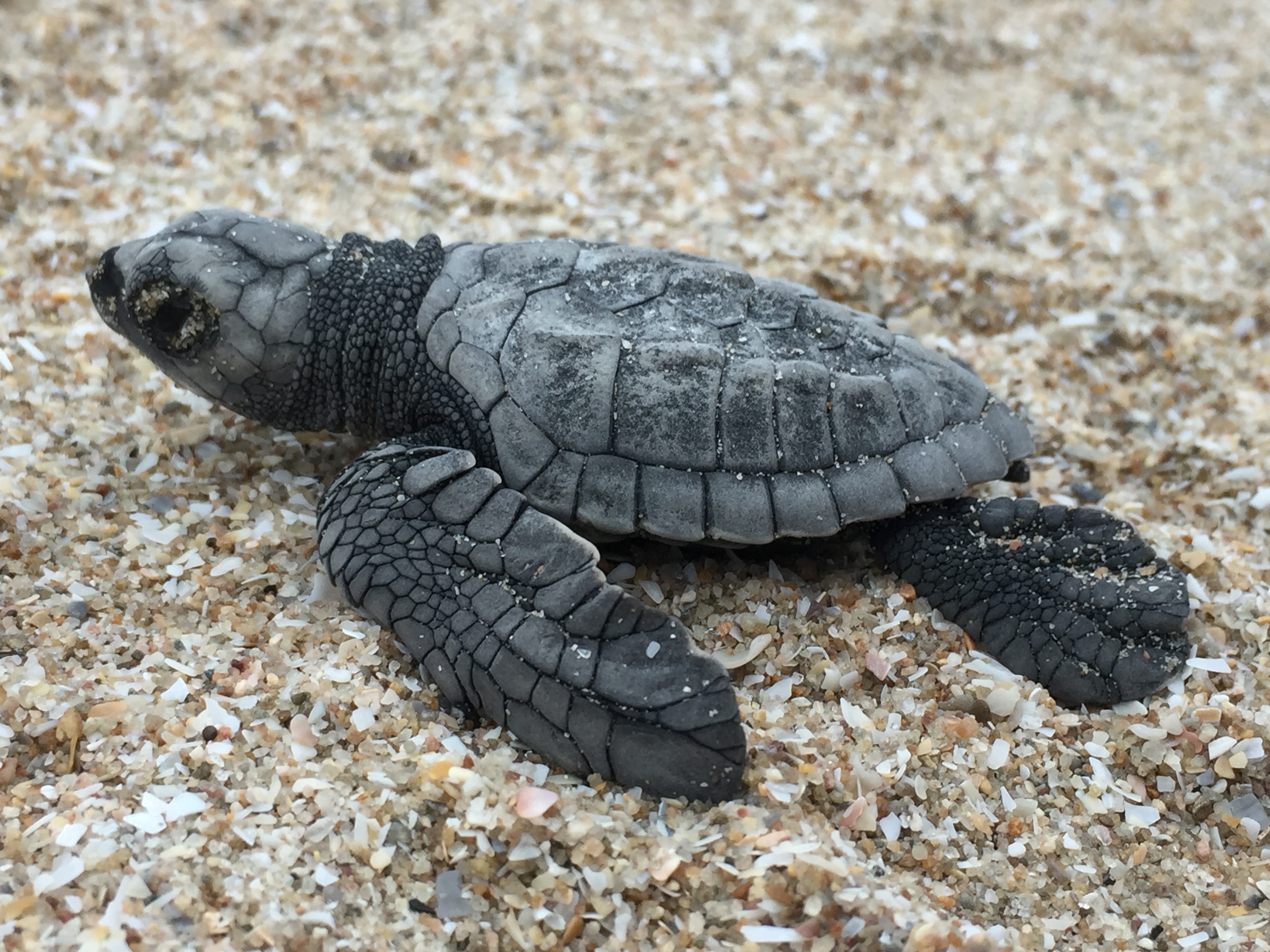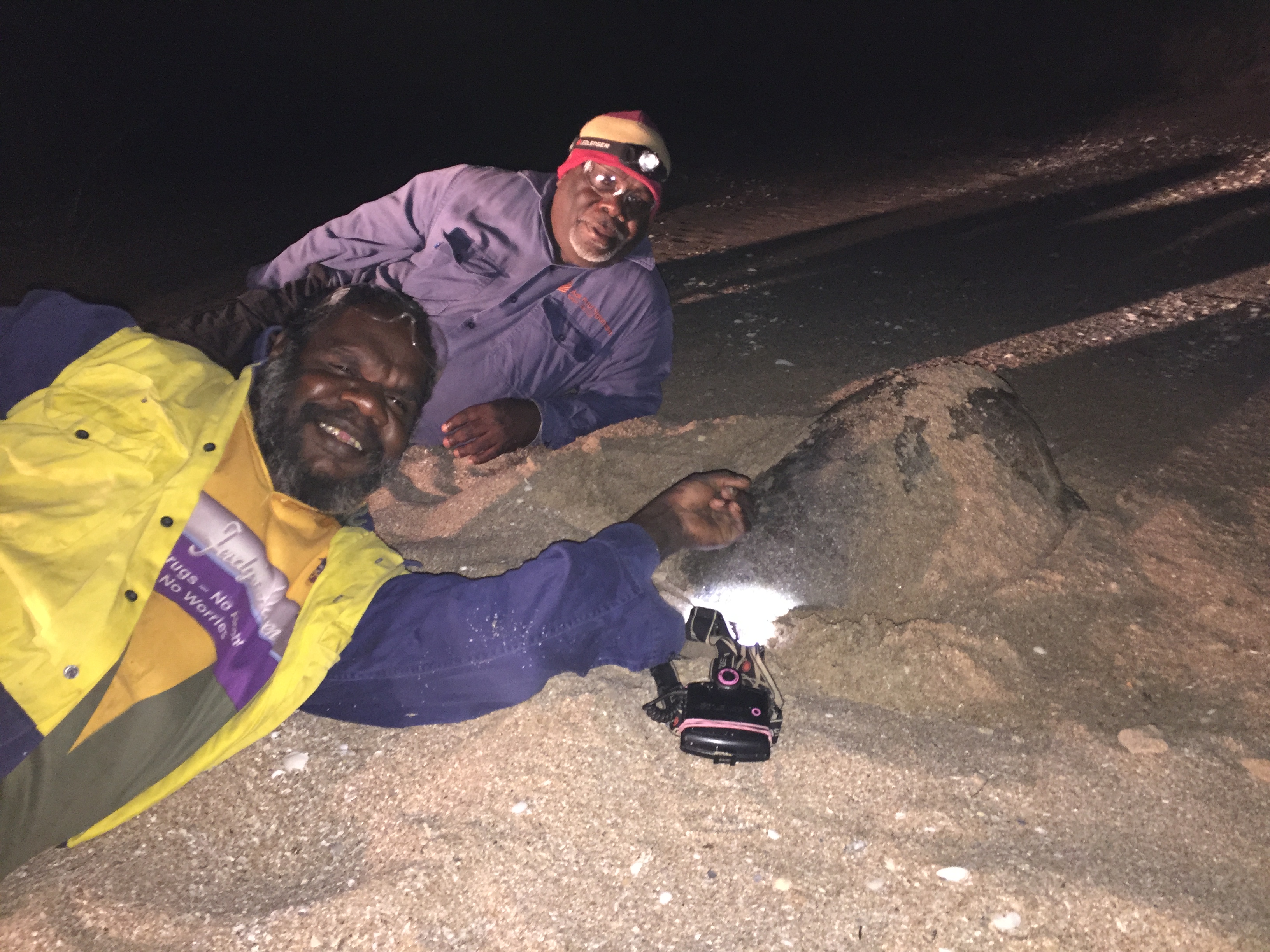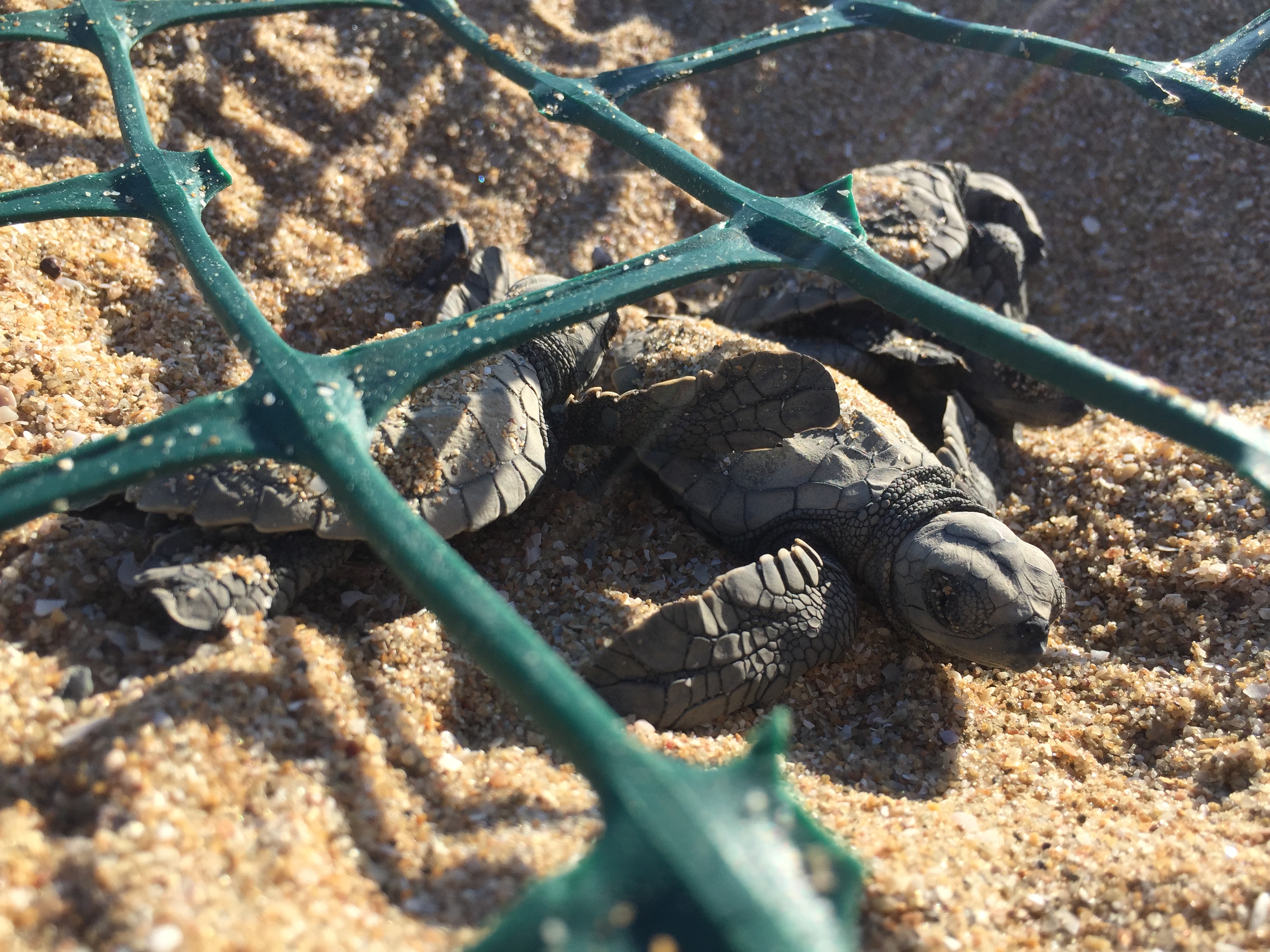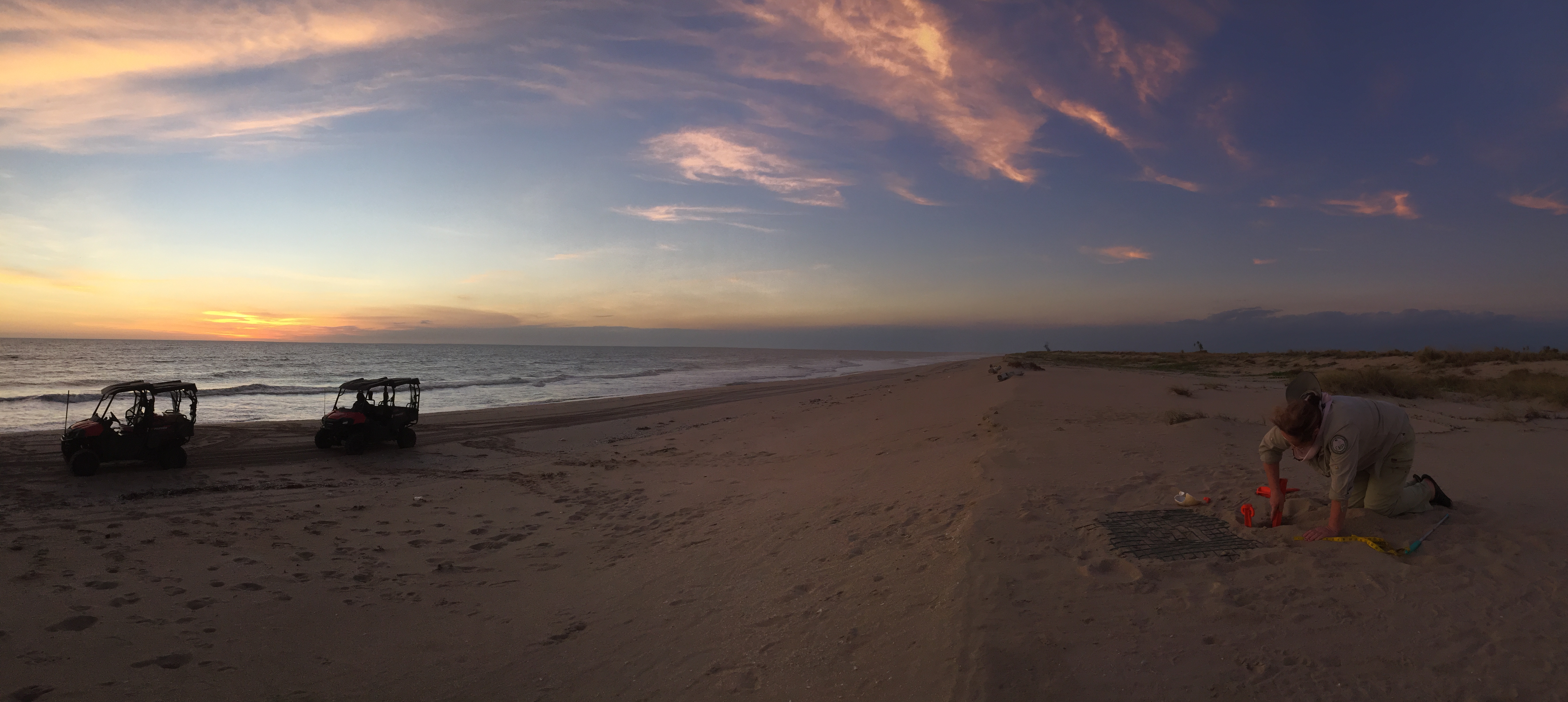
Every year thousands of sea turtles come to the beaches of the western Cape to nest. Photo by Gina Zimny
When baby sea turtles, or hatchlings, break free from their eggs they have to make a long and difficult journey to the ocean. These tiny newborns face a number of threats just trying to make it to the water’s edge. This running of the gauntlet is critical for their survival and the continuation of the species.
But before they even leave the nest they’re already under threat. Predators taking eggs from the nest is one of the most significant threats to marine turtles. Feral pigs, goannas and dingoes are disturbing turtle nests in parts of Queensland’s western Cape York Peninsula. Before our research scientist Dr Justin Perry and Indigenous rangers from Aak Puul Ngangtam (APN Cape York) started working in the area, there was 100 per cent predation on turtle nests. No baby turtles were reaching the ocean.
We’ve been working with the local community since 2008 to understand the impacts of feral animals on the ecological and economic values of northern Australia. Justin and his team focussed on a biocultural assessment to understand the impacts on turtles and to collaboratively design a solution with local people.
“This was a big problem and the management actions being applied weren’t working,” Justin said.
“The science and monitoring was separated from the management, and management was separated from the community.”

Turtles survey team on Cape York beach. Photo by Gina Zimny
Forging a pig plan together
“We brought together the regional bodies that were responsible for managing pigs and turtles to create the Northern Nest Project. This was when we started to look at the turtle problem in a holistic way,” Justin said.
The working group decided to tackle the problem using a targeted control method. They trialed a baiting system to target the specific pigs that were coming onto the beach and eating the eggs.
This control method was not popular with Traditional Owners as the effects on other species such as dingoes and birds were unknown. The scientists ran a very small-scale project, monitoring every bait station with cameras and providing regular reports. The efforts were rewarded. The following year there was a 100 per cent success rate for baby turtles hatching and reaching the ocean.

Turtle measurements are essential to improving our understanding. The data is collected at night. Photo by Gina Zimny
Specific predation plans
After this success, we (through the Northern Australia Environmental Resources Hub project) and APN funded a full-time researcher to patrol the beach during the turtle nesting season. This provided a complete overview of the predation events and turtle nesting habits across the year. Once the team started measuring the pig impacts, they could see the impact of other predators in the area.
Another Indigenous group had been using cages to stop feral pigs. But the aluminum cages were heavy and hard to manage. So Justin and his team decided to test the effectiveness of inexpensive and easy to carry garden mesh for protecting nests from predators. APN’s resident scientist, Gina Zimny, meshed hundreds of nests across the season. When the team tallied up the impact, it was clear that this method was only stopping a handful of predators. The mesh protected nests from hungry dingoes but only stopped around 10 per cent of goannas. And they were helpless against the destructive power of feral pigs.

Mesh protects turtle hatchlings from predation but still enables them to head for the ocean. Photo by Gina Zimny
Protecting the nests of marine turtles from raids by pigs, dingoes and goannas requires species-specific management strategies. To tackle this challenge, we designed an interactive dashboard that combined all the data that had been collected for the past four years. This way rangers could see how effective their management efforts had been.
On target
Justin said the most efficient way of controlling predation was linking the monitoring data with management.
“Everyone agreed that the value was getting more baby turtles into the ocean. And turtle experts had set a target of 70 per cent of nests hatching to maintain a healthy population.
“To hit this metric of success, we knew we had to apply an adaptive management process to the problem,” Justin said.

Cape York. Photo by Gina Zimny
“We’re working towards providing an immediate feedback loop on predation. The idea is to link an iPad application with a cloud server. Then when the rangers return every night, a summary dashboard updates and provides all the data required to react to the situation.
“It’s such a vast landscape so the only way to win is to tackle one small task at a time. Trying to control the entire pig population is not feasible. But targeting the egg-eating individuals can be done and we have shown that it works,” Justin said.
This year we are working on automating the data analysis and summaries so that rangers get to see what’s happening on their beaches in real-time. Having real-time data linked with planned management responses will close the adaptive management loop. And it will give the baby turtles the best chance of making it from nest to ocean.


23rd March 2022 at 12:30 pm
thank you Louisa for sharing these great projects , i am a student at CDU trying to put together my own version of a project design wotking with the Engineers without borders in the Yirrandji country in Cairns up to port douglas. the monitoring of the nests is vital . i would love to visit the sites you have metnioned . lets hope that all the people working together with Indigenous ranges and using their great knowledge we can assist these precious creatures. thank you . kroina hawthorne CDU
19th November 2019 at 1:15 am
Hello I’m aditya ayu from eleven senior high school in semarang, Indonesia.I am interested in the article about protecting baby turtles from predators that take eggs from the nest.In Indonesia, there are a number of animals that are now included in the protected category because of its existence is getting fewer, one of which is a rhino. the cause of the rhino is almost extinct because of the increasing number of humans, it makes the existence of animals disturbed. In addition, not a few of these animals are killed to take some of their organs because they have a high sale value.
I hope we as humans can maintain the existence of other living things.
thankyou.
19th November 2019 at 12:54 am
Dear Louise Jeckells
hello i’m Fara Aulia from Eleven Senior High School, Semarang Indonesia. i’m very interesting about your an article. Saving baby turtles is a good program. we have to help the turtles escape their predators. so the turtle can still life. i’m so proud of your group, that is a good idea. good luck for this year program when you working on automating the data analysis and summaries so that rangers get to see what’s happening on their beaches in real-time.i hope that we can save the baby turtles together.
7th November 2019 at 3:39 pm
Hello my name Adam Caniza i from Eleven Senior High School Semarang Indonesia.., I Have read your article and it is very interesting because I have the same problem about your article..,but I keep the seeds of tilapia from predators in the form of snakes, monitor lizards and even from humans who fish or capture fish, Nila Fish is a pond from my father that I must guard and requires a lot of struggle and patience but all paid off when all the fish are big and ready to be eaten when Eid…,4.01